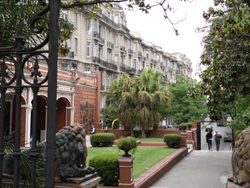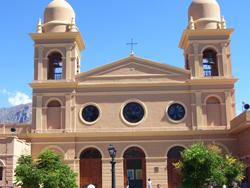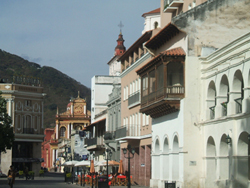Hidden Argentina | Trip Itinerary
2014 Departure Dates:
March 16-27; April 6-17; May 4-15; June 22-July 3; August 24-Setember 4; September 21-Oct 2;November 2-13; November 30-December 4
 DAY 1: BUENOS AIRES. Arrival in Buenos Aires. Meeting at the International airport and transfer to the hotel. Accommodation at the Intersur Recoleta or Hotel Pulitzer. NOTE: There is a reciprocity fee imposed to enter Argentina. For US citizens this fee is $160, and can be paid in dollars or pesos, by cash, credit card or travelers checks . This fee is collected on your arrival to Buenos Aires Ezeiza airport. Settle in to your hotel, with the afternoon free to explore on your own. This afternoon enjoy a guided walking tour to get a quick glimpse of the city and the area near to your hotel. We recommend arriving a day or two early if you wish to explore this wonderful city a bit more in-depth, take in a tango show, etc.
DAY 1: BUENOS AIRES. Arrival in Buenos Aires. Meeting at the International airport and transfer to the hotel. Accommodation at the Intersur Recoleta or Hotel Pulitzer. NOTE: There is a reciprocity fee imposed to enter Argentina. For US citizens this fee is $160, and can be paid in dollars or pesos, by cash, credit card or travelers checks . This fee is collected on your arrival to Buenos Aires Ezeiza airport. Settle in to your hotel, with the afternoon free to explore on your own. This afternoon enjoy a guided walking tour to get a quick glimpse of the city and the area near to your hotel. We recommend arriving a day or two early if you wish to explore this wonderful city a bit more in-depth, take in a tango show, etc.
DAY 2: BUENOS AIRES – SAN JUAN – VILLA UNION. Transfer to the domestic airport for the early morning flight to San Juan. Arrival in San Juan. Meet at the airport and drive to Villa Union.
We start our drive towards Jachal; the road that leads to this natural Oasis was known –until the beginning of the XXth century as “The Traverse (La Travesia)”. It meant a difficult two day ride on horseback or six on carriages drawn by mules. Today it is a spectacular and panoramic landscape of isolated land dunes.
We drive past Pismanta Hot Springs, the Oasis at Rodeo and we head towards the East to the Jachal mountain and the Cuesta del Viento (Mountain Pass). The name of this canyon is due to the strong wind that blows in the narrow gorge and reaches the Valley of Jachal and the village of the same name.
San Jose de Jachal is a lovely and peaceful village with adobe houses of italian style. After a short visit we drive along the legendary Route 40 to the North passing the Los Cauquenes Dam. The road climbs steeply with beautiful vistas to reach the Huaco Pass a beautiful mountain pass that leads to Guandacol,which was part of the Old Inca Road between Cusco and the Northern Valleys in Argentina.
While the sun starts to set we reach Villa Union. We will able to get beautiful photos of this unique landscape. Accommodation at Hoel Canon de Talampaya/check-in for a 3 night stay. (B, BL).
DAY 3 & 4: VISIT ISCHIGUALASTO, TALAMPAYA PARKS & LAGUNA BRAVA We will spend two full days at Villa Union from where we will visit Ischigualasto, Talampaya and Laguna Brava. Visits will be decided on site according to weather conditions.
Early morning visit to ISCHIGUALASTO (also known as Valle de La Luna) Provincial Park. Located in northwestern Argentina, Ischigualasto is a basin region of sandstone and mudstones. These arid badlands have a bizarre and rugged terrain that has given it the popular name "Valley of the Moon". We will walk in the park following the well-marked trails to reach the most amazing rock formations that were formed as a consequence of the wind erosion after millions of years.
These trails will let us appreciate the amazing “Encyclopedia” of the Triassic era that lasted for about 45 million years.
The Late Triassic (Carnian) deposits of the Ischigualasto Formation contain some of the oldest known dinosaur remains. Of those sites containing the earliest dinosaurs, Ischigualasto ranks second in fame, after the Chinle Formation of North America, but ranks first in the quality, number, and importance of its dinosaur finds. It is also the only place in the world where nearly all of the Triassic is represented in an undisturbed sequence of rock deposits, and both the overlying and underlying formations have also yielded important fossils of early dinosaurs as well as of early synapses and freshwater fish.
Afternoon exploration of TALAMPAYA NATIONAL PARK to capture the best photos with the best light shinning over the amazing red rock formations.
In addition to the scientific importance of Ischigualasto-Talampaya, these National Parks contain outstanding scenic areas that attract thousands of visitors every year. The red cliffs of Talampaya the variegated colors and strange rock formations form natural attractions. The walls of the canyon are about 160 m and they keep important imprints of the first inhabitants being its importance comparable to the Cave of the Painted Hands in Patagonia.
Ischigualasto-Talampaya represents the only known area in the world that contains a complete sequence of continental sediments with abundant fossil flora and fauna for the Triassic Period of geologic history. This period represents the origin of both mammals and dinosaurs, and offers the prospect of resolving one of the great enigmas of vertebrate paleontology-—the rise to dominance of the dinosaurs and the suppression of mammalian evolution during 150 million years.The other visit is to Laguna Brava (box lunch included), we will travel one of the most
memorable and amazing landscapes in Argentina and maybe in the World. We will get to Laguna Brava, a unique spot on the Andean Highlands; the realm of the flamingoes in a pristine area of stunning beauty and breathtaking views.
Certainly a day which will surely make the delight of any photo, nature lover! (B)
DAY 5: VILLA UNION - CHILECITO- TINOGASTA. This is a day in which we will enter one of the least visited areas in Argentina. We leave Villa Union towards Chilecito, which is connected to Villa Union by the colorful Cuesta de Miranda (Miranda Slope) of incredible beauty and a strong red color which outstands from the green vegetation, in some parts quite exuberant .
Early arrival at Chilecito, a quaint mining village surrounded by stunning valleys and mountain ranges, as well as vineyards and farms. We will explore this village and then keep driving north to visit the Museum de la Mejicana (An old mine museum which exhibits the longest cable car lift in Latin America; it reached 4400m above sea level on the Famatina range and was built between 1903/1905). Lunch at leisure in Chilecito. We then head to our next stop: Tinogasta, the gateway to the adobe route in Argentina! The route borders the Famatina Valley rich in nuts and fruits plantations which add lot of color to the area. It is truly a garden route of various greens according to the time of the year. Arrival and accommodation at Hosteria HUAYRA PUCA. (B) The road is mostly paved (only 30 km of gravel) (B)
Time permitting we will visit part of the adobe route, a 60-kilometer-long road that crosses towns and hamlets built 300 years ago which seem to have been forgotten by God. Everything from old houses and constructions to countless churches and buildings has been made with the same material and the technique: adobe. The adobe churches are maybe the biggest attraction with their round domes, their shapes and lines, their arches and especially their color, similar to terracotta. Real hand carved beauties can be found at the Oratorio de los Orquera (private chapel), Nuestra Señora de Andacollo (Church), to mention but a few.
The Hosteria called Casa Grande, made of adobe, stands at 800 Moreno Street, a few meters away from the main square. The adobe walls of this recycled construction are an example of how this noble building material, if properly managed, may be used to provide beauty, luxury and comfort at the same time.
DAY 6: TINOGASTA – ROUTE 40 – CAFAYATE. This will be a long day but there will be plenty of opportunities to discover and mingle with the very friendly local people. Everything for everybody! From Tinogasta we will drive to Londres, located 15 km west of Belen; founded in 1558 it is said to be Argentina´s second oldest city after Santiago del Estero. Then comes Belen, locally known as the “Capital del Poncho”, where –time permitting - we can visit where these colorful woollies are made. From Belen we drive along the mythical route 40 to reach Santa Maria. We will drive by a desserted area interrupted by small oasis and maybe be guest at the house of two important argentine artists that have chosen Santa Maria as their place in the world; we then get to Amaicha del Valle, hometown of the local native artist – Cruz- who has built in his own private house a very interesting Cultural Museum (Centro Cultural Pachamama) which deserves a visit Following Amaicha, we reach Quilmes Ruins. Visit of the Ruins hiking on its ancient trails and passes. The natives where so fierce that the Spaniards had had to work very hard to dominate them. When visiting the ruins one can appreciate the level of expertise and knowledge that these natives had. The Small citadel overlooks the valley but its location is hidden in the mountains and cannot be seen from afar. Our final destination of the day is CAFAYATE, not only the most important city in the Calchaqui valleys, but a tiny paradise for wine lovers looking for a tranquil hideaway. It is also home to some of the vineyards featuring grape varieties such as Malbec and Cabernet Sauvignon and the local’s specialty – The Torrontes. This Spanish grape produces a white wine of fruity but dry and distinctive flavor that has found its perfect terroir in the Cafayate and Calchaqui valleys. The first Torrontes vines were planted in 1850 on the La Florida vineyard which was owned by the Etchart Family. Nowadays it has passed into the hands of Pernod Ricard, the famous wine & Spirits group. Accommodation at VIÑAS de CAFAYATE hotel (Cafayate wine resort). (B, BL) A long driving day with only 30 km of gravel.
 DAY 7: CAFAYATE – CACHI along the Calchaqui Valleys We start with a morning visit of CAFAYATE, a small city home of the true argentine varietal –the Torrontés wine, where a visit to a local winery (tasting included!) should not be missed. Then we will drive one of the most remarkable roads in the Andean Highlands, part of the Calchaqui Valleys with small villages along the way that deserve a visit. We will pass by Bodega Colome (and time permitting we can stop for a brief visit and lunch) and then resume our trip to visit the small village of Molinos, and its crafts market, and then Cachi. This quaint village is the perfect example of the life and the style of the villages in the Northwest, small, nice, peaceful, yet interesting and full of life. Accommodation at EL CORTIJO Hotel Boutique in Cachi. (B) Mostly gravel road.
DAY 7: CAFAYATE – CACHI along the Calchaqui Valleys We start with a morning visit of CAFAYATE, a small city home of the true argentine varietal –the Torrontés wine, where a visit to a local winery (tasting included!) should not be missed. Then we will drive one of the most remarkable roads in the Andean Highlands, part of the Calchaqui Valleys with small villages along the way that deserve a visit. We will pass by Bodega Colome (and time permitting we can stop for a brief visit and lunch) and then resume our trip to visit the small village of Molinos, and its crafts market, and then Cachi. This quaint village is the perfect example of the life and the style of the villages in the Northwest, small, nice, peaceful, yet interesting and full of life. Accommodation at EL CORTIJO Hotel Boutique in Cachi. (B) Mostly gravel road.
DAY 8: CACHI - SALTA Visit the ancient town of Cachi (2300m / 7544 ft), with its old restored colonial church (national historic monument) and its local archaeology museum – considered one of the best of its kind in Argentina. The small village of Cachi is located within a short distance form Los Cardones National Park western border. This is a National park populated by thousands of huge cardon cacti. The park is also crisscrossed by myriad stone trails constructed by colonizing Inca forces in the 15 th century. At 3620 m (11874 ft) above sea level, the trail levels off at La Piedra del Molino, and we find the amazing Cuesta del Obispo (Obispo pass). Climb the impressive CUESTA del OBISPO (Obispo Pass) where condors, eagles and guanacos will be a frequent sight. Doubling back and forth as it descends, the road eventually leads to the Valle Encantado (Enchanted Valley) a huge, verdantly green valley comes into view. As we descend, condors can be easily seen gliding overhead.
We then head North to Salta skirting the rust-colored tobacco fields at the city’s edge to then reach the city, our final destination of the day. Accommodation at HOTEL ALDABA. (B) Mostly paved road with some patches of gravel.
DAY 9: SALTA. Rest day. In the morning we will explore the city. Salta is one of the oldest cities founded in the country by the Spaniards. The main point of interest will be the Cabildo (Town Hall), the Archbishop’s Palace and Cathedral all around the main square (9 de Julio), San Francisco´s church, San Bernardo´s church and convent, and the Crafts market. Balance of the day at leisure. Accommodation at HOTEL ALDABA. (B)
 DAY 10: SALTA – THE ROAD TO THE CLOUDS - TILCARA Early morning departure to start a ride up the Andean Range, stop for a visit to SANTA ROSA de TASTIL, the largest and best-preserved pre-Hispanic ruins in Argentina.
DAY 10: SALTA – THE ROAD TO THE CLOUDS - TILCARA Early morning departure to start a ride up the Andean Range, stop for a visit to SANTA ROSA de TASTIL, the largest and best-preserved pre-Hispanic ruins in Argentina.
We will cross the tracks of the famous TRAIN TO THE CLOUDS, the highest railroad in South America. This railroad built in the 1930s connects Salta city with the native town of San Antonio de los Cobres, traversing the most impressive heights and valleys of the Andean range, climbing to reach 4000 m above sea level on its way.
Arrival and visit at San Antonio de los Cobres. Afterwards we continue north to reach the SALINAS GRANDES (Great Salt Beds) the most imposing Salt Bed in the Northwest of Argentina. Once here we will be able to appreciate the rudimentary exploitation of the salt. We will then pass by Abra Potrerrillo at 4170 m above sea level and drive the way down the LIPAN SLOPE, a winding road that leads to the charming village of Purmamarca (2300mts above sea level). Purmamarca, is at the foot of the amazing Cerro de los Siete Colores. This polychromatic mountain (considered an artist’s palette of colors) is best seen from a hill on the edge of the village, and is a backdrop of this enchanted village where you will be able to enjoy the most interesting purchases in the local market. After a short visit we drive to Tilcara to spend the night. Accommodations at POSADA DON JUAN, Tilcara. Today we will have the longest drive of the trip on gravel. (B, BL)
DAY 11: HUMAHUACA- SALTA- BUENOS AIRES Full day expedition enjoying the multicolored landscape of the Humahuaca canyon, the peaceful villages, old chapels, native markets, small museums, and the remains of an ancient pre-Inca fortified town. Humahuaca, Uquia, Tilcara, Maimara and Purmamarca will be some of the fascinating stops during our day. The Quebrada de Humahuaca, an Andean gorge of rust-colored mountains and ancient settlements is one of Argentina’s most distinctively South American Natural experiences.
We start exploring Tilcara: The red streets and easy access makes Tilcara the favorite of all visitors. Within walking distance (a short trek outside town) is the Pucará, a restored pre-Columbian fort which offers spectacular views. The access fee (to be paid locally) includes the access to the Museo Arqueologico which houses an excellent and diverse collection.
Humahuaca with its narrow shaded streets of adobe houses is a picturesque village worth exploring. We will stroll leisurely while visiting to the local church, the Town Hall famous for its clock tower where a mechanical San Francisco Solano gives a daily blessing at noon. A visit to the Museo Arqueologico should not be missed; guided by Don Sixto or his son, the Museo pictures the lives of the “coyas”, the local inhabitants, their traditions and celebrations, their everyday life, their houses, in a simple yet interesting way. (Entrance fee to be paid locally). Return to Salta and transfer to the airport. Fly to Buenos Aires. Arrival transfer from the domestic airport to the hotel. Accommodation. (B)
Day 12: Buenos Aires. Day at leisure until the time for the transfer to the international airport. ***Hotel rooms will be available until noon** (B)
B=Breakfast, L=Lunch, BL-Box Lunch, D=Dinner
Departures
Mar 16-27
Apr 6-17
May 4-15
Jun 22-Jul 3
Aug 24-Sep 4
Sep 21-Oct 2
Nov 2-13
Nov 30-Dec 4
Group Departures
$4500 p/p
Single supp $1050
Private departures available on request
